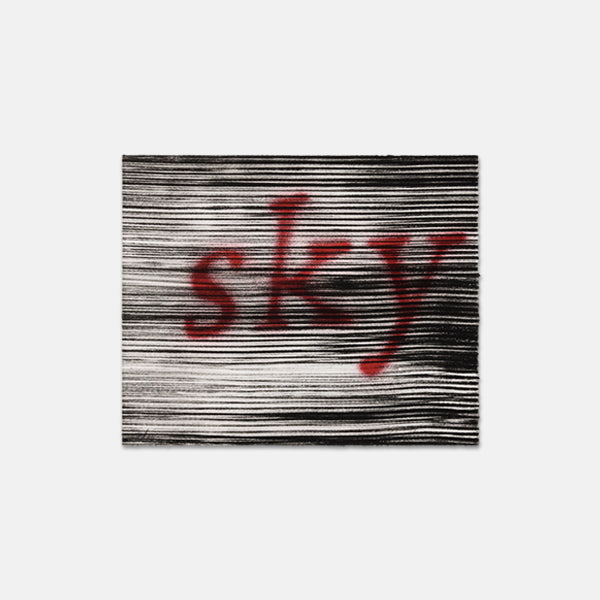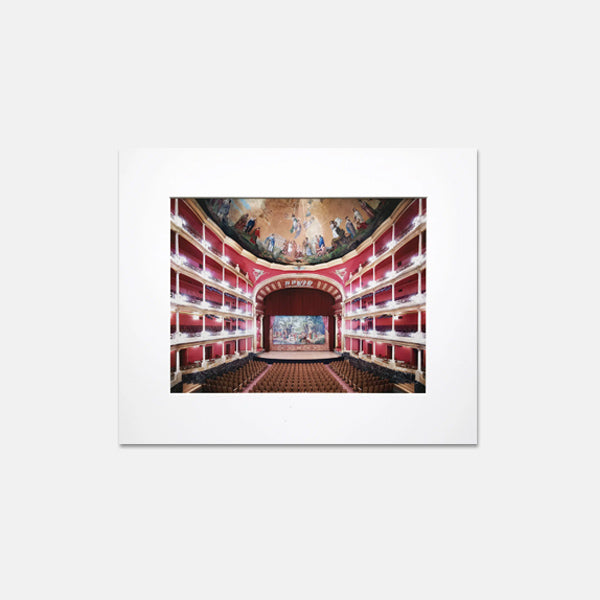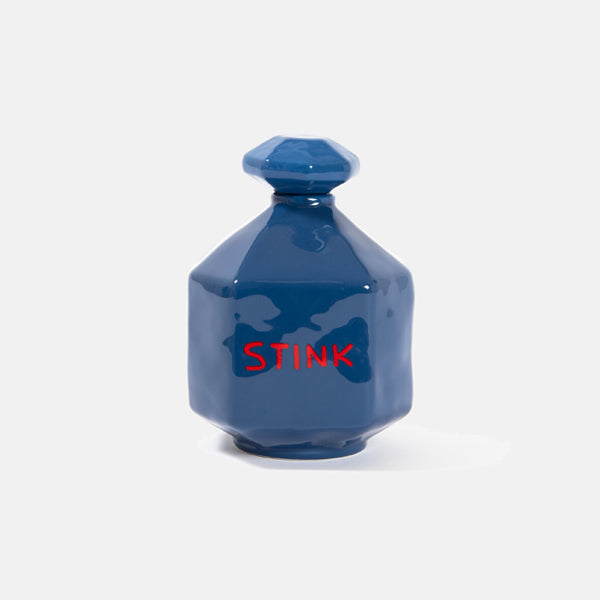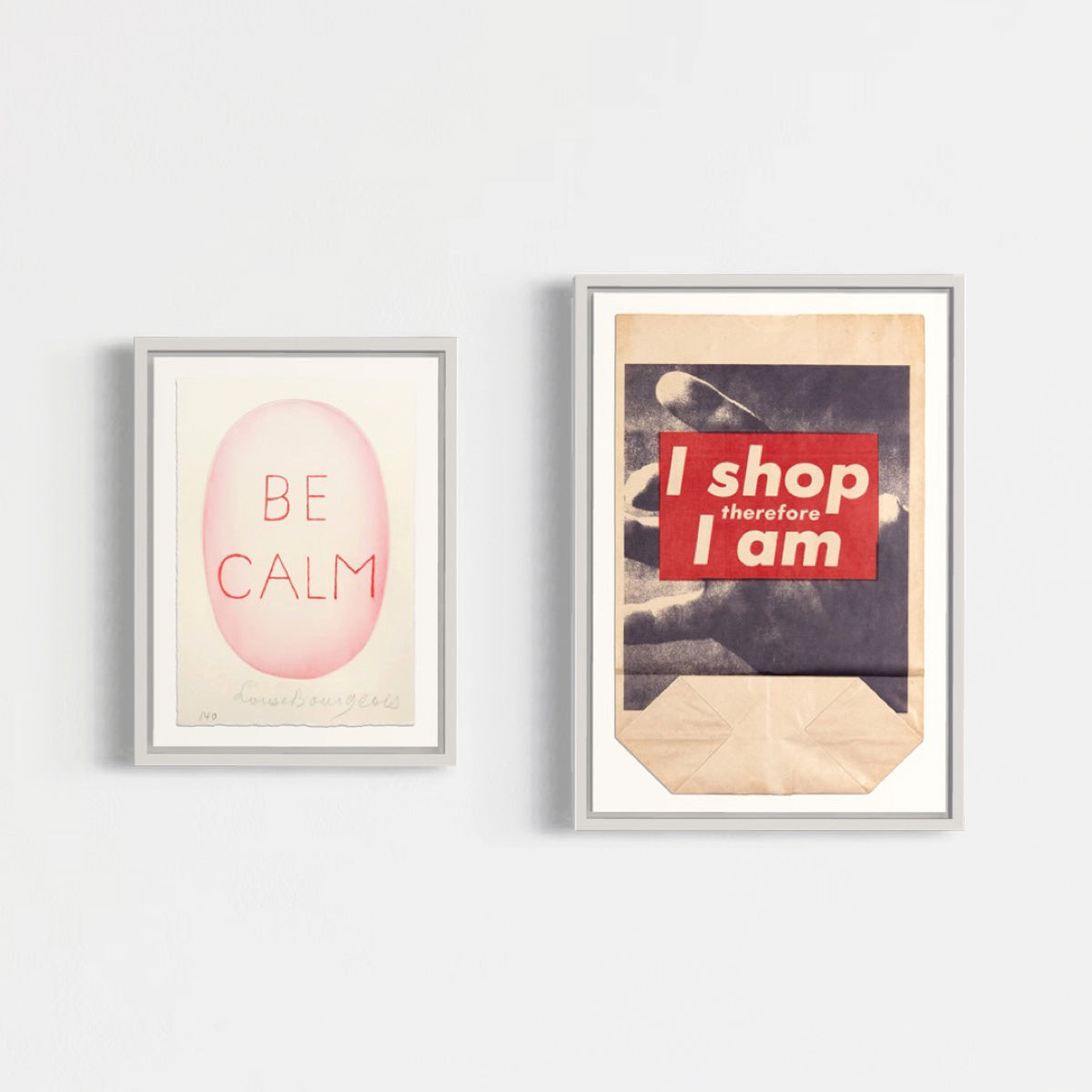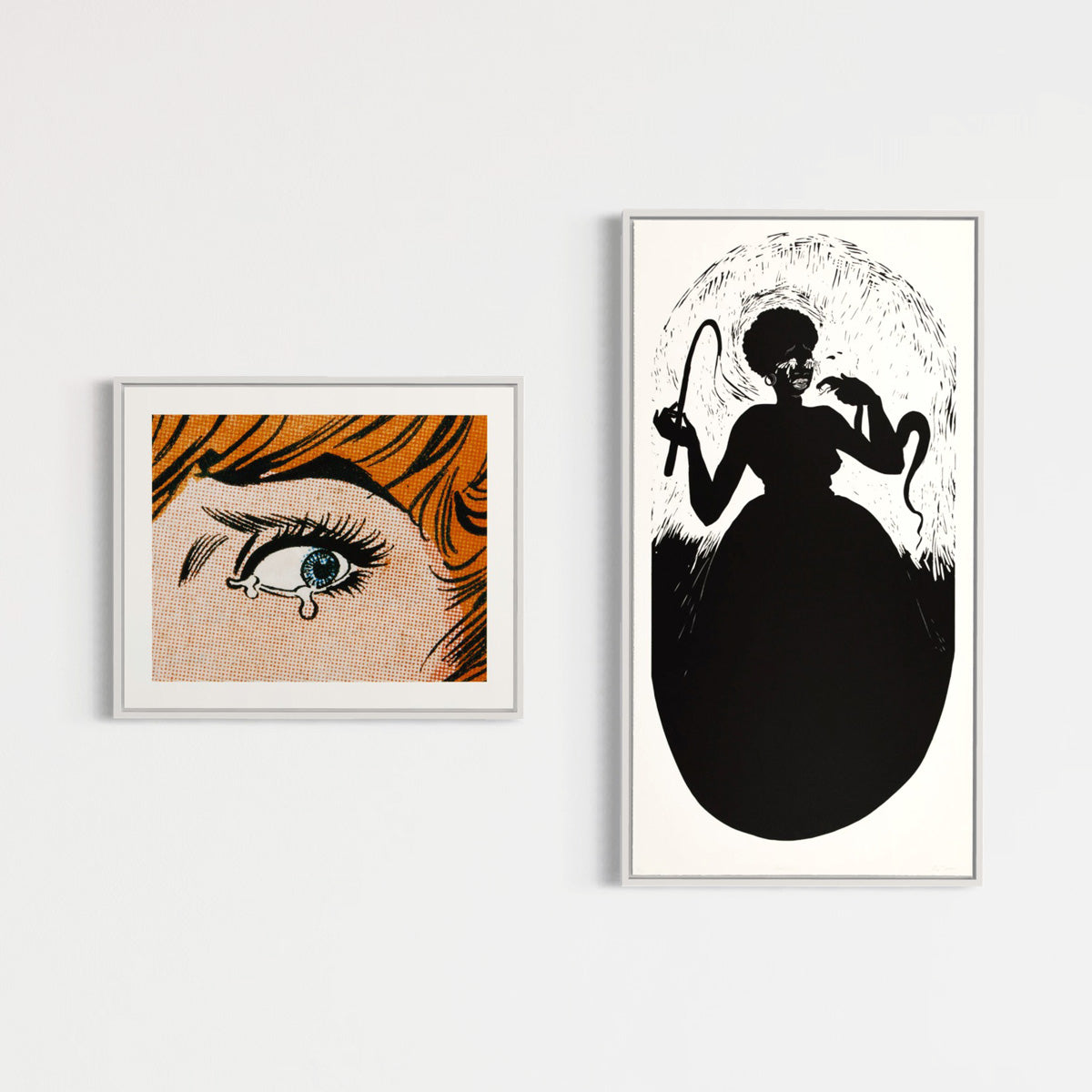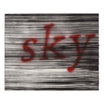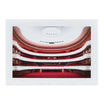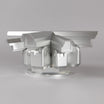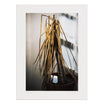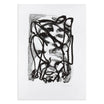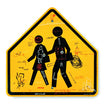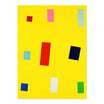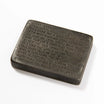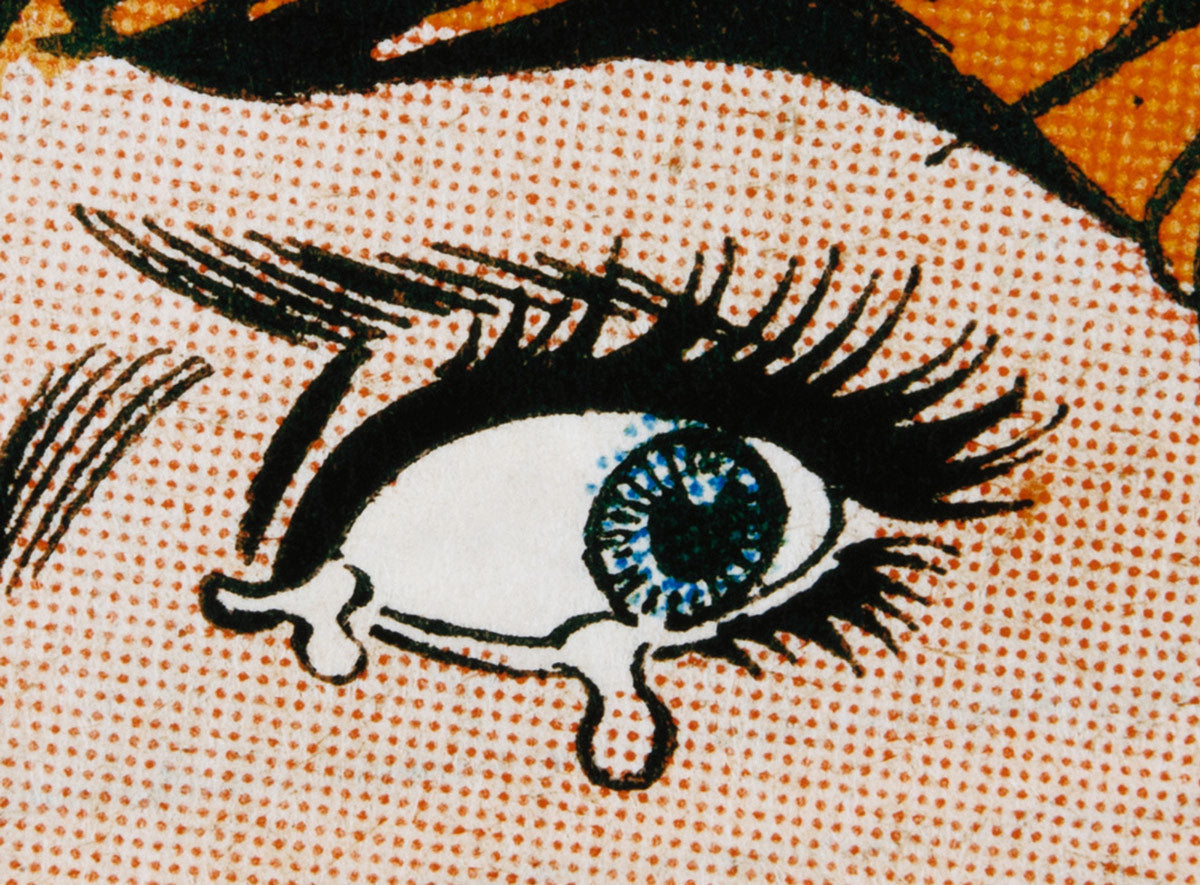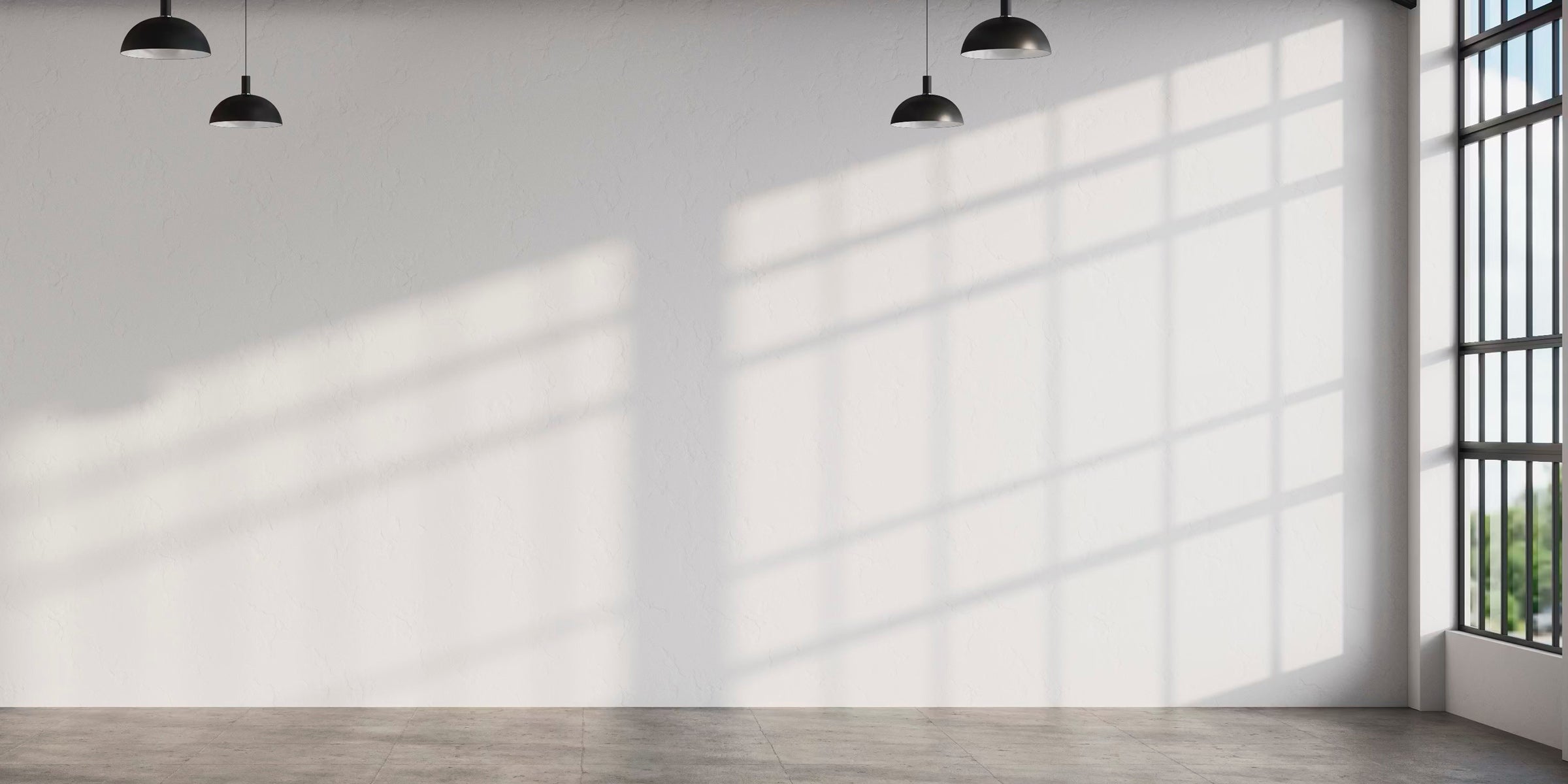This glossary provides clear explanations of key terms used in editioned artworks, printmaking, photography, and sculpture multiples. Whether you are collecting contemporary prints, researching techniques, or exploring how editions are produced, this guide helps you understand essential vocabulary and production methods. Use the A–Z navigation to quickly browse and discover specific terms related to editions.
A
Aquatint
An intaglio technique that creates tonal areas by acid etching a textured rosin ground on a metal plate.
Aquatint is an etching technique used to produce tonal areas rather than lines. A metal plate is coated with powdered rosin and gently heated so the particles adhere, then placed in an acid bath so the exposed metal is bitten around the rosin grains. This creates a fine, textured surface that holds ink. By masking areas or repeating the acid, artists can build graded tones from light grey to deep black before inking, wiping and printing the plate on damp paper.
Archival Pigment Print
A high-quality print made using pigment-based inks on archival papers, known for longevity and color stability.
Archival pigment prints are produced on professional inkjet printers using pigment-based inks and carefully selected, lightfast papers. Compared with dye-based prints or standard digital output, they offer greater resistance to fading and color shift when properly displayed and stored. They have become a standard for museum-quality photographic and digital art editions and are widely accepted as original fine art prints when clearly editioned and documented.
Artist’s Book
A book created as an original artwork, often produced in limited editions.
In an artist’s book the form of the book itself is the medium: structure, sequencing, typography and materials are all part of the artistic concept. Artist’s books can be hand printed, digitally produced or sculptural, and may include prints, photographs, drawings or text. They are typically signed, sometimes numbered, and treated as works of art rather than as conventional publications.
Artist’s Proof (A.P.)
Prints or multiples set aside for the artist, separate from the numbered edition.
Artist’s proofs historically allowed the artist to check quality during printing, but today they are a small group of impressions outside the main numbering, commonly around ten percent of the edition. They are generally identical in appearance to the regular edition but marked A.P., E.A. or similar instead of a fraction such as 5/30. Their existence and number should be disclosed as part of the edition’s documentation.
Analog Print / Darkroom Print
A photographic print produced using traditional darkroom processes and light-sensitive materials.
Analog prints are made by exposing photographic paper to light through a negative or transparency and then processing the paper in chemical baths. They may be fiber-based or resin-coated and show the tonal and surface qualities associated with classic silver gelatin or chromogenic processes. Many collectors value darkroom prints for their tactile presence, depth of tone and historical continuity with twentieth-century photography.
B
Block
The carved or prepared surface used to produce a relief print such as a woodcut or linocut.
In relief printing the block carries the design that will be printed in ink. The artist cuts away the non-printing areas, leaving the image in relief so it can be rolled with ink and transferred to paper. Blocks may be made of wood, linoleum or other suitable materials, and their texture, hardness and wear all influence the look of the printed impressions over time.
Bon à Tirer (B.A.T.)
The final proof approved by the artist, used as the standard for the edition.
Bon à tirer, French for “good to print,” is the proof the artist signs off once they are satisfied with color, inking, registration and overall balance. The printer uses this proof as a benchmark when printing the rest of the edition. The B.A.T. is usually retained by the printer or publisher and is not part of the numbered edition, but it documents the intended quality of the finished work.
Bookplate
A small printed label, sometimes collectible, designed to indicate ownership of a book.
Bookplates, or ex libris, often combine text and imagery to represent an individual owner or institution. They can be produced by etching, engraving, woodcut, lithography or other techniques and are sometimes created by well-known artists. Many are collected as miniature original prints, valued for their design and as traces of personal or institutional collecting histories.
C
Catalogue Raisonné
A comprehensive, annotated listing of all known artworks by an artist.
A catalogue raisonné for prints and editions documents titles, dates, techniques, dimensions, edition sizes, states, inscriptions, publishers and provenance information. It may appear as a book or an online database and is a key reference for authentication and scholarship. For collectors, it helps confirm that a work is complete, properly described and placed correctly within the artist’s oeuvre.
Cibachrome Print
A highly saturated, glossy color photographic print made on Cibachrome / Ilfochrome materials from transparencies.
Cibachrome, later known as Ilfochrome, is a dye-destruction process in which the dyes are built into the paper and selectively bleached away during processing. The result is exceptional color saturation, deep blacks and very sharp detail. The materials are no longer manufactured, so existing Cibachrome prints form a finite and often sought-after category within color photographic prints.
Chine Collé
A printmaking technique where thin paper is bonded to a heavier sheet during printing.
In chine collé a delicate sheet, often with a refined surface or special color, is placed on the inked plate with adhesive and backed by a stronger support paper. Under pressure in the press, the thin paper adheres and receives the printed image simultaneously. This allows artists to combine the visual subtleties of fine papers with the durability and handling advantages of more robust supports.
Chromogenic Print (C-print)
A color photographic print made using chromogenic materials and chemical processing.
Chromogenic prints are created on light-sensitive color papers that are exposed either optically in the darkroom or via digital devices and then processed in RA-4 chemistry. The dyes are formed within the emulsion during development, producing continuous-tone images with characteristic color rendering. For decades C-prints were the standard for color photography in both commercial labs and fine art practice.
Collage
A work created by assembling different materials onto a surface.
Collage can incorporate printed papers, photographs, textiles, found objects, drawing and paint. In editions, collage elements may be added by hand to each impression, creating unique variants that sit between multiples and unique works. It can also be the starting point for a print that reproduces the layered composition through photographic or digital means.
Collotype
A photomechanical printing process that produces continuous-tone images without a visible halftone screen.
Collotype uses a light-sensitive gelatin layer on a plate that, when exposed and processed, develops a finely reticulated surface capable of holding ink in varying densities. It was historically used for high-quality book illustration and photographic portfolios. Collotype prints are valued for their rich tonal range and soft, almost velvety appearance, and can be considered original prints when conceived as such by the artist.
Colophon
A statement in a book or edition giving details about its production, materials, or printing.
A colophon typically appears at the end of an artist’s book, portfolio or limited edition and may list printers, typefaces, papers, edition size, numbering structure and any special subsets such as artist’s proofs or hors commerce impressions. It provides a concise record of how, when and in what quantity the edition was produced and is an important document for collectors and institutions.
Contact Print
A photographic print made by placing a negative directly onto the paper during exposure.
In contact printing the negative and paper are pressed together under glass and exposed to light, producing a one-to-one scale image. This method can yield exceptional sharpness and tonal fidelity and is common in large-format photography and historical processes. Contact sheets of small negatives are also used for editing and study, showing full film strips or rolls on a single page.
D
Deckle Edge
The natural, feathery edge found on handmade or mould-made papers.
Deckle edges arise where the paper pulp does not form a sharp cut edge at the mold. Many fine art papers preserve this irregular boundary as a sign of craft and authenticity. In prints and photographs, showing deckle edges through float mounting or wide margins emphasizes the sheet as an object and indicates that it has not been trimmed from a larger parent sheet.
Debossing
A recessed impression pressed into the paper, creating a sunken image or area.
Debossing is the counterpart to embossing: instead of raising the paper surface, a plate, die or type is pressed downward so the design sits below the surrounding plane. It can be used for titles, borders, patterns or subtle framing devices in prints, books and portfolios. Debossing emphasizes tactility and can be combined with ink or used as a blind impression.
Digital Archival Print
A print made with pigment-based inks on archival papers via digital methods.
Digital archival prints are created from digital files using high-end printers, pigment-based inks and papers selected for lightfastness and stability. They combine the flexibility of digital imaging with materials intended for long-term display. Many contemporary photographers and artists use digital archival printing as their primary edition format, often specifying exact printers, profiles and papers in their documentation.
Digital Pigment Print
A high-resolution inkjet print using pigment inks.
In a digital pigment print, microscopic droplets of pigment-based ink are sprayed onto the paper in controlled patterns. Because pigments are solid particles rather than dissolved dyes, they offer better resistance to fading when properly matched to high-quality papers. Digital pigment prints can show fine detail, smooth tonal transitions and a wide color gamut and are widely regarded as suitable for museum-quality editions.
Digital Print
A print produced using digital files and printing technologies.
Digital print is an umbrella term for prints made from digital image files rather than directly from analogue negatives, plates or blocks. In fine art contexts this typically includes inkjet prints (often archival pigment prints) and digital C-type prints such as Lambda. Because quality and materials vary widely, it is important to specify inks, papers and processes when describing a digital print in an edition.
Diptych
An artwork made up of two related panels or parts presented as a single work.
Diptychs may consist of two prints, photographs or mixed-media works designed to be shown together in a specific order and spacing. They can be printed on separate sheets or combined within one frame. In editioned contexts, a diptych is typically sold and catalogued as a single work, even though it contains two physical elements.
Drypoint
An intaglio technique where the artist scratches directly into the plate, creating a rich, burr-like line.
In drypoint the artist uses a hard needle to incise lines into a plate without acid. The displaced metal forms a burr along the edges of the groove, which catches ink and prints as a soft, velvety mark. Because the burr is fragile and wears down quickly under pressure, early impressions often show stronger, more atmospheric lines than later ones, which can affect both appearance and desirability.
E
Edition
The total number of prints or multiples made from a single matrix.
An edition is typically limited, signed and often numbered by the artist, with the total quantity clearly stated in a fraction or colophon. Once the edition is declared complete, no further impressions from the matrix should be produced, aside from any documented proofs. Transparent, consistent editioning practices are fundamental to trust in the market for prints, photographs and multiples.
Embossing
A raised impression created without ink, using pressure alone.
Embossed images are formed when a plate, block or die is pressed into damp paper so the fibers are displaced into a raised or recessed shape. Embossing can be subtle, as in blind stamping, or strongly sculptural and may be used on its own or combined with printed color and line. It emphasizes the physical structure of the paper and can add tactile richness to an edition.
Engraving
An intaglio technique achieved by cutting lines into a metal plate with a burin.
In engraving the artist or engraver pushes a sharp burin through the metal, lifting out slivers of material to create clean, precise grooves. Ink is worked into these lines and wiped off the surface, and the plate is printed under high pressure on damp paper. Engraving has been used for centuries for book illustration, maps and banknotes as well as fine art prints, valued for its clarity and control.
Etching
An intaglio process using acid to bite lines into a metal plate.
In etching a plate is coated with an acid-resistant ground and the artist draws through this layer to expose the metal. The plate is then submerged in acid, which bites into the exposed lines. After the ground is removed, the plate is inked, wiped and printed on damp paper. Etching supports fluid, hand-drawn lines and is often combined with aquatint, drypoint and other techniques to create complex images.
Estate Stamp / Estate Stamped
An artwork authorized and stamped by an artist’s estate after their death.
Estate stamps may be applied to existing impressions, posthumous prints or casts, or works that were unsigned during the artist’s lifetime. The stamp indicates control or approval by the estate or foundation but is distinct from a hand signature. Documentation should clarify whether a stamped work is a lifetime impression, a later printing or a posthumous cast so that its status is fully understood.
F
Found Object
An everyday object incorporated into an artwork rather than created from traditional art materials.
Found objects may be used as sculptural elements, incorporated into collage or assemblage, or transformed through minimal intervention. In the context of multiples and editions they can appear in boxed sets, portfolios or mixed-media works where each edition may include identical or similar found components. The term overlaps with “readymade” but is often used more broadly.
Foundry Proof (F.P.)
A proof made at the foundry during the casting of a sculpture, typically for quality control.
Foundry proofs are usually identical to regular casts but reserved for the workshop that produced the edition. They are commonly marked F.P. or similar and kept as records of the casting. Along with numbered casts, artist’s proofs and any other proof categories, they should be included when declaring the total number of impressions associated with a sculptural edition.
G
Gelatin Silver Print
A black-and-white photographic print made on light-sensitive paper coated with silver salts.
Gelatin silver prints are produced by exposing silver gelatin paper under an enlarger and processing it through developer, stop bath and fixer. They became the standard for black-and-white photography in the twentieth century and, when properly processed and washed, have excellent archival stability. Many vintage and modern prints collected today in black-and-white photography are gelatin silver prints.
Giclée Print
A marketing term often used for inkjet prints; technically an archival pigment print.
The term giclée originally referred to fine art inkjet prints but is now used loosely in the market. It does not by itself guarantee archival quality, so information about inks, printers and papers is essential. Many artists and publishers prefer more precise terms like “archival pigment print” to describe high-quality inkjet editions produced to fine art standards.
Grano Lithograph
A lithograph printed from a stone or plate prepared with a fine grain to accept detailed drawing.
In grano lithography the stone or plate surface is grained to a specific fineness, allowing delicate tonal work and precise line. The term is sometimes used in cataloguing to distinguish fine-art lithographs from coarser commercial litho. As with other lithographs, grano lithographs are printed from the flat surface using the principle that oil and water repel.
H
Heliogravure
An early term for photogravure, an intaglio process that translates photographic images into etched plates.
Heliogravure combines photography and copperplate etching by transferring a light-sensitive image to the plate and etching it in stages so different areas hold different amounts of ink. The resulting prints show rich blacks, subtle highlights and a characteristic grain. The term is often used interchangeably with photogravure, especially in historical contexts.
Hors Commerce (H.C.)
Prints not intended for sale, historically for printers or publishers.
Hors commerce impressions are typically identical in appearance to the numbered edition but marked H.C. instead of with an edition fraction. They were often used for display, promotion or collaborators and not offered for public sale. Today their number and status should be disclosed along with the edition size and other proof categories when describing a print.
I
Impression
A single print taken from a matrix.
An impression is one physical instance of a print or multiple. An edition consists of a defined number of impressions plus proofs, and individual impressions can differ slightly in inking, paper tone and condition. When cataloguing or collecting prints it is important to distinguish between the matrix, the edition as a whole and the particular impression in hand.
Inkjet Print
A print made using inkjet technology, not necessarily archival unless pigment-based.
Inkjet printers work by spraying tiny droplets of ink onto a surface in patterns controlled by a digital file. In fine art printing, the most highly regarded inkjet prints use pigment-based inks and archival papers, often marketed as archival pigment prints. Other inkjet outputs may be suitable for proofs or short-lived applications but lack the same long-term stability.
Intaglio
A family of techniques where ink is held in the recesses of a plate.
Intaglio includes etching, engraving, drypoint, mezzotint and aquatint. In these processes the artist creates incised lines or textures below the plate surface, which are filled with ink and then wiped so the surface is largely clean. Damp paper is pressed into the recesses under high pressure, picking up the ink and often leaving a visible plate mark around the image.
L
Leporello
A concertina-folded booklet or artwork.
Leporellos unfold in a zigzag sequence and can present images, text or both as a continuous visual flow. They are frequently used in artist’s books and portfolios where the physical act of unfolding and refolding is part of the viewing experience. In editioned form, leporellos may be housed in cases or boxes that are integral to the work’s design.
Letterpress
A relief printing process using movable type or plates.
In letterpress printing, raised letters or image plates are inked and pressed into paper, sometimes leaving a subtle debossed impression. Historically the dominant method for books and ephemera, letterpress is now used mainly for fine press books, invitations and artist’s publications. It can be combined with other printmaking techniques within complex editions.
Linocut
A relief print created from a carved linoleum block.
The artist cuts away the non-printing areas of a linoleum sheet, leaving the design in relief to receive ink. Linoleum’s smooth, even surface and softness make it easier to carve than wood, encouraging bold, graphic images as well as detailed designs. Linocuts can be printed by hand or with a press in one or multiple colors.
Lithography
A planographic technique using the principle that oil and water repel.
In lithography the artist draws with greasy materials on a stone or metal plate, which is then chemically treated so that the drawn areas attract oily ink while the rest holds water. During printing, the plate is kept damp and rolled with ink, transferring the image to paper. Lithography supports a wide range of marks, from crayon-like textures to washes and sharp lines.
Lambda Print
A digital exposure of photographic paper using lasers, then chemically processed.
Lambda and similar digital C-type processes use red, green and blue lasers controlled by a digital file to expose traditional color photographic paper. The exposed paper is then processed in RA-4 chemistry, producing continuous-tone prints that combine the look of chromogenic photography with the flexibility and precision of digital imaging. They are widely used for large-scale photographic editions.
M
Matrix
The surface or form from which prints are made.
A matrix can be a plate, block, stone, screen, mold or digital file interpreted by a printer. It is the source that allows multiple impressions to be created from a single design or image. The condition, preparation and, in some cases, cancellation of the matrix all play important roles in how an edition is produced, limited and documented.
Mezzotint
An intaglio technique known for deep, velvety blacks and rich tonal gradations.
Mezzotint begins with a plate that has been roughened uniformly, so if printed at this stage it would produce a solid black. The artist then smooths and burnishes areas back toward lighter tones, working from dark to light rather than from white to black. The result is an image with subtle tonal transitions and a distinctive, atmospheric depth, but the process is labor-intensive and technically demanding.
Mixed Media
An artwork that combines more than one medium or technique in a single piece.
In the context of prints and editions, mixed media might include a combination of screenprint, lithograph and collage, or a photograph with hand-applied paint and drawing. Mixed-media editions can blur the line between multiples and unique works, especially when handwork varies from impression to impression. Cataloguing should note all significant processes and materials used.
Monotype
A unique print made by painting or inking directly onto a smooth plate.
For monotypes the artist creates an image on a plate, glass or acrylic sheet and transfers it once to paper under pressure. Because there is no fixed matrix that can be re-inked to produce consistent repeats, each impression is one of a kind. A faint secondary “ghost” print may sometimes be pulled but is usually treated as a separate unique work.
Monoprint
A print with unique variations even when made from the same matrix.
In a monoprint there is an underlying repeatable element—such as a plate, block or screen—yet the artist alters each impression with changes in color, drawing, collage, overprinting or other interventions. As a result, no two impressions are exactly the same. Monoprints sit between traditional editions and unique works and should be described clearly in documentation.
Multiple
A work of art produced in multiple identical or near-identical examples, including sculpture or objects.
Artist’s multiples extend the idea of editions to three-dimensional or object-based works. They may be cast, fabricated or manufactured and are usually made in a defined edition that is signed and often numbered. Multiples allow artists to produce sculptural or design-like works that remain accessible to a broader group of collectors through controlled edition sizes.
N
Numbering
The notation indicating an edition number (e.g. 5/30).
Edition numbers are usually written as a fraction, where the numerator identifies the individual impression and the denominator the total edition size. Numbering does not typically record the exact printing sequence, but it signals that the edition is finite and fixed. Clear numbering, together with documentation, helps collectors understand scarcity and how a given impression fits into the overall edition.
O
Offset Print
A print produced using offset lithography, a commercial printing technique adapted for some artist editions.
Offset printing uses plates to transfer ink onto a rubber blanket, which then prints the paper, allowing high-speed, high-quality production. When artists conceive works specifically for offset, the resulting offset prints can be considered original editions. It is important to distinguish these from purely reproductive offset prints that simply reproduce existing paintings or drawings.
Open Edition
An edition without a fixed number of impressions.
Open editions may be printed on demand and are not limited by a predetermined edition size. They can still be signed or stamped by the artist or estate but do not offer the same degree of scarcity as limited editions. They are often used for more affordable, widely available works, while limited editions are reserved for tightly controlled series.
Outside of Edition
A designation for impressions that are not counted within the stated edition size.
Impressions described as outside of the edition may include artist’s proofs, printer’s proofs, hors commerce impressions, foundry proofs or special impressions created for portfolios or institutional gifts. They should be clearly labeled and documented so that the total number of impressions in all categories is transparent, even if only a subset is numbered as the official edition.
Unknown Edition
Used when the total edition size cannot be verified.
Unknown edition size is common in older prints, posters and photographs where records were not kept or have been lost. This does not necessarily diminish artistic significance, but it makes the questions of rarity and market supply harder to assess. In such cases it is more accurate to state that the edition size is unknown rather than guess or imply false precision.
P
Photogravure
An intaglio photographic process producing rich, continuous-tone images.
Photogravure transfers a photographic image to a copper plate, which is then etched so that different areas hold different amounts of ink. The plate is inked, wiped and printed like an etching, producing deep blacks, delicate highlights and a tactile plate mark. The process combines photographic detail with the physical presence of intaglio printing and has long been valued for its subtle, atmospheric qualities.
Plate
The metal or other surface used in intaglio printing.
Plates are most often made of copper, zinc, steel or aluminum, though plastics and other materials may also be used. They are worked by etching, engraving, drypoint or related techniques and must withstand the pressure of the press. The plate’s preparation, surface texture and eventual wear all influence the appearance of prints and the feasible size of an edition.
Pochoir
A hand-colored stenciling technique.
In pochoir, separate stencils are cut for each color area and pigment is brushed or dabbed through them onto the paper. The method was widely used in early twentieth-century fashion plates, art books and portfolios to apply vivid, opaque color by hand. In contemporary editions, pochoir can be used to add hand-applied color accents over printed images, creating a hybrid of mechanical and manual processes.
Polaroid
An instant photographic print produced by self-developing film inside the camera.
Polaroids (and other instant prints) develop directly after exposure, creating unique or small-run images with characteristic borders, color and surface. Artists often treat Polaroids as unique works, though they may also be re-photographed, enlarged or used as the basis for subsequent editions. Their physical immediacy and vulnerability are part of their appeal for collectors.
Printer / Printmaker
The technical specialist who prints the edition.
Fine art printers bring expertise in specific processes such as etching, lithography, screen printing or digital printing and work closely with artists to realize their ideas. They help translate images into suitable matrices, refine proofs and maintain consistency throughout an edition. Their role is often acknowledged in colophons or documentation and can be an important quality marker for collectors.
Printer’s Proof (P.P.)
Proofs reserved for the printer.
Printer’s proofs are usually identical to the standard edition but inscribed P.P. instead of with an edition fraction. They recognize the contribution of the printer or workshop and are typically limited to a small number. As with artist’s proofs and other proof categories, the number of printer’s proofs should be disclosed when describing the total impressions associated with an edition.
Printmaking
The art of creating prints using various techniques.
Printmaking encompasses relief, intaglio, lithography, screen printing, digital print processes and combinations of these. It allows artists to explore repetition, variation, layering and collaboration with specialist workshops. Many artists move fluidly between unique works and editions, using printmaking to circulate ideas, reach broader audiences and experiment with materials and processes.
Proof
An impression pulled to test or approve a plate, block or screen before or during editioning.
Proofs may include working proofs, trial proofs, bon à tirer, artist’s proofs, printer’s proofs, foundry proofs and other categories. They are often used to evaluate changes in color, inking, paper or state. Some proofs remain strictly working materials; others are signed and enter the market. Clear labeling and documentation are essential so that the role of each proof type within the edition is understood.
Publisher
The person or organization funding and overseeing the creation of an edition.
Publishers often initiate projects, commission artists, coordinate with printers and fabricators, and handle contracts, marketing and distribution. They may also manage documentation, certificates and archiving of editions. A publisher’s name can carry a reputation for quality and can help situate an edition within a broader context of collaborations and curated projects.
R
Readymade
An ordinary manufactured object designated by an artist as an artwork.
The term originates with Marcel Duchamp’s early twentieth-century works and has since influenced many sculptural and conceptual practices. In relation to editions, readymades may be replicated, customized or presented in series, sometimes blurring the line between unique works, multiples and found objects. Documentation is important to clarify how many examples were intended and produced.
Recto / Verso
Recto is the front of a sheet; verso is the reverse.
In prints, photographs and works on paper, the recto usually carries the main image, while the verso may contain signatures, stamps, labels or notations. Verso information can be crucial for understanding provenance, printing dates and exhibition history. Careful documentation often records both sides before framing or conservation treatments.
Relief Print
A print made from a raised surface where the image stands above the non-printing areas.
Relief prints are created when the artist removes the non-printing areas of a block or plate, leaving the design in relief. Ink is rolled onto the raised surfaces and transferred to paper by hand or with a press. Woodcut, linocut and letterpress are all relief processes, and relief prints often have a bold, graphic character that can reveal the grain of the block or the impression of type in the paper.
RC Print (Resin-coated)
A photographic paper coated with resin for faster processing and drying.
Resin-coated papers encapsulate the paper base between polyethylene layers, which reduces chemical absorption and speeds up washing and drying. RC prints are convenient and dimensionally stable, making them popular for commercial and amateur use. In fine art contexts they coexist with fiber-based prints, which many photographers and collectors prefer for their surface qualities and proven long-term stability.
Risographic Print
A print made on a Risograph duplicator using soy- or rice-based inks and stencil drums.
Risographic printing sits between photocopy, stencil and screenprint. Colors are printed in separate layers using semi-transparent inks, often resulting in slight misregistration and visible texture. Artists and small presses use risographic prints for editions, zines and posters, valuing their distinctive color, grain and relatively low production cost.
S
Screenprint (Silkscreen)
A print made by pulling ink through a mesh screen using a stencil, also known as silkscreen.
In screen printing, non-printing areas of the mesh are blocked out to form a stencil and ink is pulled across the screen with a squeegee so it passes through the open mesh onto paper or another substrate. Separate screens are used for each color, allowing flat, opaque layers and sharp edges. Screenprints, often called silkscreens or serigraphs in fine art contexts, are widely used for editions, posters and textiles.
Slipcase
A protective box or sleeve into which a book, portfolio or set of prints is slid.
Slipcases are commonly used for deluxe editions, portfolios and artist’s books to protect their contents and present them as cohesive objects. They may be made of board, cloth, card or other materials and sometimes carry printed, embossed or debossed titles. In collecting, the presence and condition of the original slipcase can affect desirability and value.
Spit Bite
An intaglio technique where acid is painted onto the plate.
Spit bite is usually applied to an aquatinted plate. The artist brushes diluted acid directly onto the surface, allowing it to etch in a more painterly, irregular way than standard line etching. The resulting marks can resemble ink or watercolor washes, giving intaglio prints a fluid, atmospheric quality that differs from purely linear methods.
Stencil
A cut-out template used to control where ink, paint or pigment is applied.
Stencils are used in pochoir, screen printing, street art and many mixed-media practices. In editioned works, stencils may be employed to apply hand-colored elements consistently across a series or to build layered designs. They can be made from paper, film, metal or other materials depending on the technique and desired durability.
Sugar Lift
A method using sugar solution to create painterly marks in intaglio.
In sugar lift the artist paints a sugar-based mixture onto a plate where they want the image to appear, then covers the plate with an acid-resistant ground. When the plate is placed in warm water, the sugar dissolves and lifts the ground, exposing the metal. The exposed areas are then etched, producing brush-like marks that can be given tone through aquatint, combining drawn and painterly effects in a single plate.
T
Trial Proof (T.P.)
A proof made to test different states before the final edition.
Trial proofs are working impressions used to evaluate changes in color, inking, paper or plate states during the development of a print. They may show rejected colorways, partial images or experimental overlays and are often unique. When signed and retained, they are usually inscribed T.P. and described as distinct from the regular edition but closely related to its evolution.
Triptych
An artwork composed of three related panels or elements presented as a single work.
Triptychs can be horizontal, vertical or arranged in other configurations and may be hinged or framed separately. In editions, a triptych might consist of three prints that are signed and numbered as one work, or three sheets printed together on a single large sheet. Cataloguing should indicate that the three parts form an integral whole.
U
Unique Variant (U.V.)
An impression that differs in some way from others in the edition.
Unique variants may involve hand-coloring, collage, drawing, experimental inking or other interventions that make each example distinct while still relating to a shared matrix or structure. They sit between standard editioned prints and one-of-a-kind works. Documentation should specify how many unique variants exist, how they differ and how they are signed and inscribed.
V
Variant / Varied Edition (V.E.)
An edition where each impression has deliberate variations.
In a varied edition, impressions share a common matrix or structure but are organized into groups or individual works with controlled differences, such as changes in color, paper, hand-applied elements or overprinting. For example, an edition of 30 might consist of three groups of 10 impressions, each with a distinct color scheme. Clear descriptions help collectors understand how the variants relate to each other and to the edition as a whole.
Varnish
A transparent coating applied to protect or alter the surface of a print or artwork.
Varnishes can deepen color, increase gloss, reduce gloss or add selective emphasis to parts of an image. In printmaking they may be applied overall or in specific areas and can be part of the original conception or added later as conservation or presentation treatment. When varnish is integral to the artist’s intent, it should be noted in cataloguing.
Vellum
A fine parchment made from animal skin, historically used as a writing and printing surface.
In the context of prints and editions, vellum or vellum-like papers may be used for special subsets of an edition, offering a distinct translucency and surface. True vellum behaves differently from paper in terms of expansion, contraction and mounting, and requires careful handling. Catalogues and colophons should specify when editions include impressions on vellum.
Vintage Print
A photographic print made close to the date the negative was created.
While definitions vary by period and medium, a vintage print is generally produced within a relatively short time after the image was made, often under the artist’s direct supervision and in the context of their original practice. Later impressions from the same negative are usually described as later or modern prints. Vintage status can influence both the historical importance and market value of photographic works.
W
Woodcut
A relief print created by carving into a wood block.
In woodcut the artist carves away the non-printing areas of a wooden block, inks the remaining surface and prints it onto paper, often revealing the grain and character of the wood. Woodcut is one of the oldest printmaking techniques and has been used across many cultures, from early book illustration to contemporary large-scale works. It supports both bold graphic designs and intricate, multi-color prints.
X
Xerox Transfer
A print or drawing made by transferring toner from a photocopy onto another surface.
Xerox transfer techniques use solvents, heat or pressure to move toner from a photocopy onto paper, canvas or other supports. Artists have used Xerox transfers since the 1960s and 1970s to incorporate photographic or graphic elements into prints, drawings and mixed-media works. Results often show characteristic grain, distortion and occasional accidents that many artists embrace.
Y
No widely used edition-related terms beginning with Y.
Z
No widely used edition-related terms beginning with Z.
